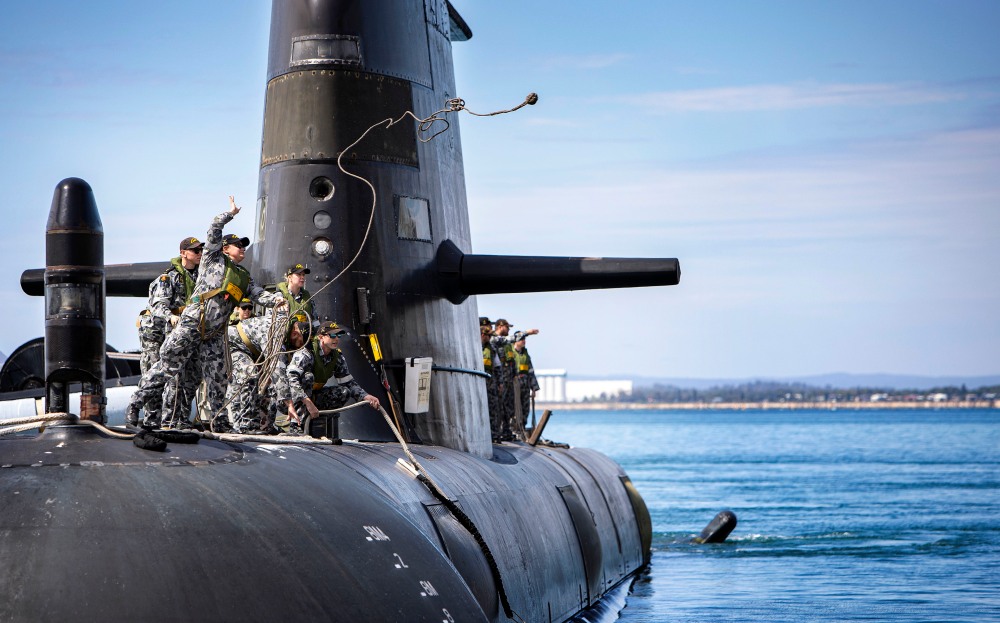Why AUKUS Alarme ASEAN
Around two decades after the end of the Cold War, the Association of Southeast Asian Nations (ASEAN) experienced a golden age. The ten member states of the organization, as well as China and the United States, saw the bloc as the key to the region’s security and economic integration. ASEAN as a collective entity has worked hard to put itself at the center of the regional architecture through a complex network of security institutions and relationships. At the height of its golden age, ASEAN believed it was in control of the region’s fortunes.
This golden age is over. Last week ASEAN, which normally needs unanimous approval to function, fought to maintain unity. After an emergency meeting on the Myanmar crisis on October 15, the bloc excluded Myanmar’s junta leaders from an upcoming ASEAN summit, a rare move for the organization. As a loose organization without a clear strategic vision of its own, it is shaken as individual members break out of their ranks and realign themselves in the new rivalry between the USA and China. The latest announcement of the new so-called AUKUS military and technology pact between Australia, Great Britain and the United States has further heightened the geopolitical interests of the region and once again put the strategic paralysis of ASEAN into the spotlight.
It shouldn’t be like that. In one of the most dynamic regions in the world, a US or China-led system would be untenable; ASEAN therefore made its virtue out of its desire to stay out of superpower conflicts. Because of its multilateral nature, consensual decision-making and lack of strategic ambition beyond its borders, ASEAN was seen as an honest, neutral broker. For the diplomats in the region, the so-called ASEAN centrality – that ASEAN will speak for the entire region when external powers are involved – has become an article of faith.
Around two decades after the end of the Cold War, the Association of Southeast Asian Nations (ASEAN) experienced a golden age. The ten member states of the organization, as well as China and the United States, saw the bloc as the key to the region’s security and economic integration. ASEAN as a collective entity has worked hard to put itself at the center of the regional architecture through a complex network of security institutions and relationships. At the height of its golden age, ASEAN believed it was in control of the region’s fortunes.
This golden age is over. Last week ASEAN, which normally needs unanimous approval to function, fought to maintain unity. After an emergency meeting on the Myanmar crisis on October 15, the bloc excluded Myanmar’s junta leaders from an upcoming ASEAN summit, a rare move for the organization. As a loose organization without a clear strategic vision of its own, it is shaken as individual members break out of their ranks and realign themselves in the new rivalry between the USA and China. The latest announcement of the new so-called AUKUS military and technology pact between Australia, Great Britain and the United States has further heightened the geopolitical interests of the region and once again put the strategic paralysis of ASEAN into the spotlight.
It shouldn’t be like that. In one of the most dynamic regions in the world, a US or China-led system would be untenable; ASEAN therefore made its virtue out of its desire to stay out of superpower conflicts. Because of its multilateral nature, consensual decision-making and lack of strategic ambition beyond its borders, ASEAN was seen as an honest, neutral broker. For the diplomats in the region, the so-called ASEAN centrality – that ASEAN will speak for the entire region when external powers are involved – has become an article of faith.
In recent years, however, the building of centrality has collapsed. As the former Singaporean diplomat Bilahari Kausikan argued, the great powers are okay with ASEAN centrality as long as it serves their interests. Individual member states have also mocked the bloc’s unity by signing their own agreements with external powers and blocking joint ASEAN actions.
The first notable crack in ASEAN’s armaments came in 2012. Cambodia, which then held the rotating chairmanship of the organization, torpedoed an important ASEAN communiqué because drafts had mentioned the dispute between several member states and China in the South China Sea. Phnom Penh is considered to be closely linked to Beijing.
But not only China is working within ASEAN to achieve its goals. The Indo-Pacific Free and Open Strategy represented by Australia, India, Japan and the United States is a case in point. The strategy has innocuous-sounding principles: freedom of navigation and overflights, compliance with international law and regional ties. But its power is to highlight principles that China rejects. Most ASEAN members are maritime states and would strongly support these principles, but public support for the US-led strategy would anger China. Fearing to upset Beijing, ASEAN has tried to take a common position.
The same goes for the Quadrilateral Security Dialogue known as the Quad, formed by the same four states – which ASEAN countries fear is another red flag for China’s cops. Though the quad is harmlessly working on tangible outcomes – such as vaccine delivery, climate action, and new technology – it can also use force in and around the South China Sea through joint military exercises and training. In August and October the navies of the four quad members conducted sea exercises in the Philippine Sea and in the Bay of Bengal, respectively. As evidence of the growing importance of these exercises, the United States announced plans to possibly involve the British Royal Navy in the future. The fact that the non-ASEAN powers in the region are making progress in the critical area of maritime security underscores ASEAN’s failure to defend itself against the Chinese assertiveness.
But nothing has shaken ASEAN like AUKUS. The new pact announced last month sees the United States and Britain supply the Australian Navy with nuclear technology to power a new generation of attack submarines that could permanently change the region’s balance of power.
Key ASEAN nations such as Malaysia and Indonesia have raised concerns about the arms race and power projection. These fears are confusing cause and effect: AUKUS is Canberra’s reassessment of its threat landscape, and the three-way deal is a response to China’s growing military power and assertiveness. In essence, AUKUS underlines the rapid geopolitical changes around ASEAN. Regional powers outside the bloc work with it whenever possible, but go their own way if necessary.
Other visions of the regional order – from the US-led Free and Open Indo-Pacific Strategy to China’s Belt and Road Initiative – now compete with ASEAN’s own perspectives for the Indo-Pacific, which the organization has outlined in an anodyne document , that dialogue and development, but bypasses more sensitive issues like the rise of China and its assertiveness in the South China Sea. Even if Asia avoids an armed conflict, it will not soon agree on a new regional order. In all likelihood, Southeast Asia will experience a long, potentially unstable, strategic interregnum.
To remain relevant, ASEAN needs to build on its established strengths in economic integration and socio-cultural connections. But even these will be difficult to navigate as trade blocs run the risk of being drawn into the US-China conflict. All 10 ASEAN countries are members of the regional comprehensive economic partnership, which also includes China. Several ASEAN countries – Brunei, Malaysia, Singapore, and Vietnam – have also signed the Comprehensive and Progressive Trans-Pacific Partnership Agreement, the successor to a supposedly US-led trade deal prior to Washington’s withdrawal in 2017, and which China now has to join asked.
ASEAN needs courageous leadership to advance the group’s internal strategic debates, resolve differences within ASEAN, and work with major powers. One step could be to appoint a group of three seasoned political leaders who are serious enough to talk about Turkey. There is a precedent in the history of ASEAN for this type of diplomacy: the ten-year war between Cambodia and Vietnam ended with an informal, sometimes secret, shuttle diplomacy that led to the 1991 Paris Peace Accords and the subsequent admission of the two countries to ASEAN . Most importantly, the proposed trio of heavyweights would have to be free to operate outside of ASEAN’s official structures lest they suffer the same fate as the bloc’s petty envoy for Myanmar.
As if to underline its own irrelevance and impotence, ASEAN always responded to problems with explanations – and even more explanations. Brunei, which holds the rotating chairmanship of ASEAN this year, drafted the statement by ASEAN leaders on maintaining multilateralism in 2021, which is due to be adopted at an upcoming ASEAN summit. The text will “reaffirm ASEAN’s commitment to uphold and promote multilateral cooperation enshrined in international law in order to achieve peace, security, stability and prosperity in the region and beyond”. These words are unlikely to revive ASEAN.
It is now painfully evident that disagreement within ASEAN is growing day by day. At the emergency meeting on Friday, the bloc’s foreign ministers discussed the question of the Myanmar junta’s participation in this month’s ASEAN summit in Brunei. The ministers achieved only a weak consensus: Although the head of the State Administration Council of Myanmar, Min Aung Hlaing, has been removed, a high-ranking official from Myanmar will take over the seat of the country.
Whatever ASEAN does, the great powers will not wait for the group to work together. The Biden government continues to stress that it wants to work with ASEAN as a bloc, but that does not prevent it from cultivating closer ties with individual ASEAN states such as Singapore and Vietnam. Members of the bloc may not want to choose between Beijing and Washington, but will instead cultivate relationships with both – understandable given ASEAN’s inability to develop a common security policy.
In the end, ASEAN will rummage through. But one remembers Dorian Gray, the famous figure of the poet Oscar Wilde: behind its bright, misleading surface, ASEAN is getting old.


Comments are closed.